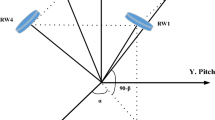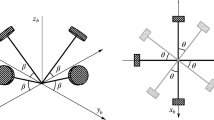Abstract
This paper presents a new scheme for fault detection and isolation in a satellite system. The purpose of this paper is to develop detection, isolation and identification algorithms based on a cascade filter for both total and partial faults in a satellite attitude control system (ACS). The cascade filter consists of a decentralized Kalman filter (DKF) and a bank of interacting multiple model (IMM) filters. The cascade filter is utilized for detection and diagnosis of anticipated sensor and actuator faults in a satellite ACS. Other fault detection and isolation (FDI) schemes are compared with the proposed FDI scheme. The FDI procedure using a cascade filter was developed in three stages. In the first stage, two local filters and a master filter detect sensor faults. In the second stage, the FDI scheme checks sensor residuals to isolate sensor faults, and 11 Extended Kalman filters with actuator fault models detect wherever actuator faults occur. In the third stage of the FDI scheme, four filters identify the fault type, which is either a total or partial fault. An important feature of the proposed FDI scheme is that it can decrease fault isolation time and accomplish not only fault detection and isolation but also fault type identification using a scalar penalty in the conditional density function.
Similar content being viewed by others
References
I. Hwang, S. Kim, Y. Kim, and C. E. Seah, “A survey of fault detection, isolation, and reconfiguration methods,” IEEE Trans. on Control Systems Technology, vol. 18, no. 3, pp. 636–653, May 2010.
J. Gertler, “Survey of model-based failure detection and isolation in complex plants,” IEEE Control Systems Magazine, vol. 8, no. 6, pp. 3–11, 1988.
R. Iserman, “Model based fault detection and diagnosis methods,” Proc. of the American Control Conference, vol. 3, pp. 1605–1609, Seattle, Washington, 1995.
M. Tafazoli, “A study of on-orbit spacecraft failures,” Acta Astronautica, vol. 64, no. 2–3, pp. 195–205, Jan. 2009.
R. H. Chen, H. K. Ng, J. L. Speyer, L. S. Guntur, and R. Carpenter, “Health monitoring of a satellite system,” Journal of Guidance, Control, and Dynamics, vol. 29, no. 3, pp. 593–605, 2006.
A. Lee and M. Brown, “A model-based thruster leakage monitor for the Cassini spacecraft,” Proc. of the American Control Conference, IEEE, Piscataway, NJ, pp. 902–904, June 1998.
Y. Zhang and J. Jiang, “An interacting multiplemodel based fault detection, diagnosis and fault tolerant control approach,” Proc. of the 38th Conf. Dec. Control, Phoenix, AZ, pp. 3593–3598, Dec. 1999.
Y. Zhang and X. R. Li, “Detection and diagnosis of sensor and actuator failures using IMM estimator,” IEEE Trans. Aerosp. Electron. Syst., vol. 34, no. 4, pp. 1293–1313, Oct. 1998.
Y. Zhang, X. R. Li, and K. Zhou, “A fault detection and diagnosis approach based on hidden Markov chain model,” Proc. of the American Control Conference, Philadelphia, Pennsylvania, pp. 2012–2016, Jun. 1998.
Y. Zhang and J. Jiang, “Integrated active faulttolerant control using IMM approach,” IEEE Trans. on Aerospace and Electronic Systems, vol. 37, no. 4, pp. 1221–1235, Oct. 2001.
S. Kim, J. Choi, and Y. Kim, “Fault detection and diagnosis of aircraft actuators using fuzzy-tuning IMM filter,” IEEE Trans. on Aerospace and Electronic Systems, vol. 44, no. 3, pp. 940–952, 2008.
N. Tudoroiu and K. Khorasani, “Satellite fault diagnosis using a bank of interacting Kalman filters,” IEEE Trans. Aerosp. Electron. Syst., vol. 43, no. 4, pp. 1334–1350, Oct. 2007.
A. Okatan, C. Hajiyev, and U. Hajiyeva, “Kalman filter innovation sequence based fault detection in LEO satellite attitude determination and control system,” Proc. of Recent Advances in Space Technologies, 3rd International Conference, pp. 411–416, June 14–16. 2007.
W. R. Williamson, J. L. Speyer, V. T. Dang, and J. Sharp, “Fault detection and isolation for deep space satellites,” Journal of Guidance, Control, and Dynamics, vol. 32, no. 5. pp. 1570–1584, Sep. 2009.
F. N. Pirmoradi, F. Sassani, and C. W. de Silva, “Fault detection and diagnosis in a spacecraft attitude determination system,” Acta Astronautica, vol. 65, no. 5–6, pp. 710–729, Sep. 2009.
R. J. Patton, F. J. Uppal, S. Simani, and B. Polle, “Robust FDI applied to thruster faults of a satellite system,” Control Engineering Practice, vol. 18, Sep. 2010.
C. H. Won, “Comparative study of various control methods for attitude control of a LEO satellite,” Aerospace Science and Technology, no. 5, pp. 323–333, Feb. 1999.
R. Mehra, S. Seereeram, D. Bayard, and F. Hadaegh, “Adaptive Kalman filtering, failure detection and identification for spacecraft attitude estimation,” Proc. of the 4th IEEE Conference Control Applications, pp. 176–181, Sep. 1995.
M. J. Sidi, Spacecraft Dynamics and Control: A Practical Engineering Approach, Cambridge University Press, Cambridge, UK, 2000.
R. J. Patton, “Fault detection and diagnosis in aerospace systems using analytical redundancy,” Computing Control Engineering Journal, vol. 2, no. 3, pp. 127–136, May 1991.
T. E. Menke and P. S. Maybeck, “Multiple model adaptive estimation applied to the VISTA F-16 flight control system with actuator and sensor failures,” Proc. of IEEE Nat. Aerosp. Electron. Conference Dayton, OH, pp. 441–448, May. 1992.
M. Ilyas, J. Lim, J. Lee, and C. G. Park, “Federated unscented Kalman filter design for multiple satellite formation flying in LEO,” Proc. of International Conference on Control, Automation, and Systems, Seoul, Korea, pp. 453–458, Oct. 2008.
P. S. Maybeck and P. D. Hanlon, “Performance enhancement of a multiple model adaptive estimator,” IEEE Trans. on Aerospace and Electronic Systems, vol. 31, no. 4, pp. 1240–1254, Oct. 1995.
J. Liu, Y. Zhu, J. Lai, and Y. Yu, “Inner attitude integration algorithm based on fault detection for strapdown inertial attitude and heading reference system,” Chinese Journal of Aeronautics, vol. 23, no. 1, pp. 68–74, Feb. 2010.
M. T. Yang, J. L. Guan, and J. C. Gu, “High impedance faults detection technique based on wavelet transform,” International Journal of Electrical, Computer and Systems Engineering, vol. 1, no. 3, pp. 308–312, Mar. 2007.
J. Bae and Y. Kim, “Attitude estimation for satellite fault tolerant system using federated unscented Kalman filter,” International Journal of Aeronautical & Space Science, vol. 11, no. 2, pp. 80–86, Feb. 2010.
P. S. Maybeck and R. D. Stevens, “Reconfigurable flight control via multiple model adaptive control methods,” IEEE Trans. Aerosp. Electron. Syst., vol. 27, no. 3, pp. 470–480, May 1991.
Author information
Authors and Affiliations
Corresponding author
Additional information
Recommended by Editorial Board member Young Jae Lee under the direction of Editor Myotaeg Lim.
This journal was supported by NSL (National Space Lab) program through the Korea Science and Engineering Foundation funded by the Ministry of Education, Science and Technology (20110018663).
Junhan Lee received his B.S. degree in Aerospace Engineering from Chungnam National University in 2007 and an M.S. degree in Mechanical and Aerospace Engineering from Seoul National University in 2011. His research interests include fault detection, isolation and recovery (FDIR) systems and inertial navigation systems (INS).
Chan Gook Park received his B.S., M.S., and Ph.D. degrees in Control and Instrumentation Engineering from Seoul National University in 1985, 1987, and 1993, respectively. He worked as a postdoctoral fellow at the Engineering Research Center for Advanced Control and Instrumentation in Seoul National University in 1993. From 1994 to 2003 he worked with Kwangwoon University as an Associate Professor. In 2003, he joined the faculty of the School of Mechanical and Aerospace Engineering at Seoul National University, where he is currently a Professor. In 1998, he worked with Prof. Jason L. Speyer about peak seeking control for formation flight at the University of California, Los Angeles (UCLA) as a visiting scholar. His research interests include filtering techniques, inertial navigation systems, GPS/INS integration, and personal navigation systems.
Rights and permissions
About this article
Cite this article
Lee, J., Park, C.G. Cascade filter structure for sensor/actuator fault detection and isolation of satellite attitude control system. Int. J. Control Autom. Syst. 10, 506–516 (2012). https://doi.org/10.1007/s12555-012-0307-7
Received:
Revised:
Accepted:
Published:
Issue Date:
DOI: https://doi.org/10.1007/s12555-012-0307-7




